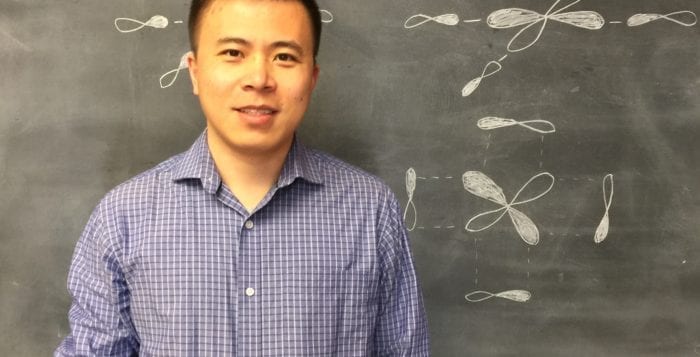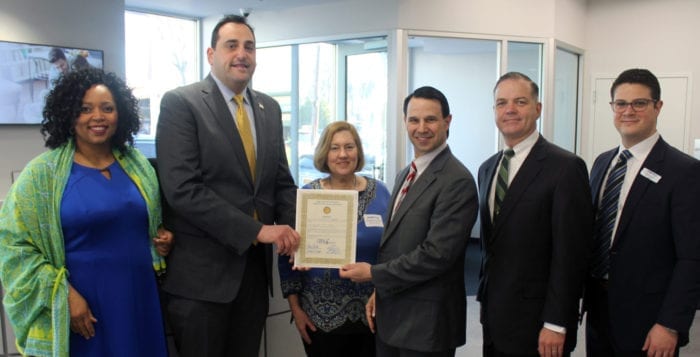Yearly Archives: 2019
Rocky Point developer plans to build homes at Miller Place Surf Club
A once-private community club in Miller Place has sat unused for close to three years, but now a Rocky Point developer is planning to turn the site into townhomes.
Rocky Point’s Landmark Properties, owned by developer Mark Baisch, announced it had purchased the Miller Beach Surf Club, located at 23 Harbor Beach Road. The site closed in 2016 due to a lawsuit over its catering, according to Kyle Markott of Markott Realty. Since the 1960s, the site was home to a private beach club before turning into a wedding venue
in 2006.
Markott Realty facilitated the transaction and Markott said as a child he visited the location when it was still a local clubhouse for residents to barbeque and relax on the beach.
“It was a really beautiful place,” he said.
Baisch said the current buildings on the five-acre parcel would be bulldozed to install four waterfront townhouses, with two houses to each building. Each structure is two floors sized at 3,000 square feet, and would contain an attached garage.
More information on the proposed townhouses can be found at:
BNL’s Enyuan Hu ‘positively impacts’ battery research
By Daniel Dunaief
Charging and recharging a battery can cause a strain akin to working constantly without a break. Doctors or nurses who work too long in emergency rooms or drivers who remain on the road too long without walking around a car or truck or stopping for food can function at a lower level and can make mistakes from all the strain.
Batteries have a similar problem, as the process of charging them builds up a structural tension in the cathode that can lead to cracks that reduce their effectiveness.
Working with scientists at Brookhaven National Laboratory and the Stanford Synchrotron Radiation Lightsource, Enyuan Hu, an assistant chemist at BNL, has revealed that a doughnut-shaped cathode, with a hole in the middle, is more effective at holding and regenerating charges than a snowball shape, which allows strain to build up and form cracks.
At this point, scientists would still need to conduct additional experiments to determine whether this structure would allow a battery to hold and regenerate a charge more effectively. Nonetheless, the work, which was published in Advanced Functional Materials, has the potential to lead to further advances in battery research.
“The hollow [structure] is more resistant to the stress,” said Hu. Lithium is extracted from the lattice during charging and changes the volume, which can lead to cracks.
The hollow shape has an effective diffusion lens that is shorter than a solid one, he added.
Yijin Liu, a staff scientist at Stanford’s Linear Accelerator Center (SLAC) and a collaborator on the project, suggested that the result creates a strategic puzzle for battery manufacture.

Photo from Enyuan Hu
“On the one hand, the hollow particles are less likely to crack,” said Liu. “On the other hand, solid particles exhibit better packing density and, thus, energy density. Our results suggest that careful consideration needs to be carried out to find the optimal balance.” The conventional wisdom about what caused a cathode to become less effective involved the release of oxygen at high voltage, Hu said, adding that this explanation is valid for some materials, but not every one.
Oxygen release initiates the process of structural degradation. This reduces voltage and the ability to build up and release charges. This new experiment, however, may cause researchers to rethink the process. Oxygen is not released from the bulk even though battery efficiency declines. Other possible processes, like loss of electric contact, could cause this.
“In this specific case of nickel-rich layered material, it looks like the crack induced by strain and inhomogeneities is the key,” said Hu.
In the past, scientists had limited knowledge about cracks and homogeneity, or the consistent resilience of the material in the cathode.
The development of new technology and the ability to work together across the country made this analysis possible. “This work is an excellent example of cross-laboratory collaboration,” said Liu. “We made use of cutting edge techniques available at both BNL and SLAC to collect experimental data with complementary information.”
At this point, Hu estimates that about half the battery community believes oxygen release causes the problem for the cathode, while the other half, which includes Hu, thinks the challenge comes from surface or structural problems.
He has been working to understand this problem for about three years as a part of a five-year study. His role is to explore the role of the cathode, specifically, which is his particular area of expertise.
Hu is a part of a Battery500 project. The goal of the project is to develop lithium-metal batteries that have almost triple the specific energy currently employed in electric vehicles. A successful Battery500 will produce batteries that are smaller, lighter and less expensive than today’s model.
Liu expressed his appreciation for Hu’s contributions to their collaboration and the field, saying Hu “brings more than just excellent expertise in battery science into our collaboration. His enthusiasm and can-do attitude also positively impacts everyone in the team, including several students and postdocs in our group.”
In the bigger picture, Hu would like to understand how lithium travels through a battery. At each stage in a journey that involves diffusing through a cathode, an anode and migrating through the electrolyte, lithium interacts with its neighbors. How it interacts with these neighbors determines how fast it travels.
Finding lithium during these interactions, however, can be even more challenging than searching for Waldo in a large picture, because lithium is small, travels quickly and can alter its journey depending on the structure of the cathode and anode.
Ideally, understanding the journey would lead to more efficient batteries. The obstacles and thresholds a lithium ion needs to cross mirror the ones that Hu sees in everyday life and he believes he needs to circumvent these obstacles to advance in his career.
One of the biggest challenges he faces is his comfort zone. “Sometimes, [comfort zones] prevent us from getting exposed to new things and ideas,” he said. “We have to be constantly motivated by new ideas.”
A cathode expert, Hu has pushed himself to learn more about the anode and the electrolyte.
A resident of Stony Brook, Hu lives with his wife, Yaqian Lin, who is an accountant in Port Jefferson, and their son Daniel, who attends Setauket Elementary School.
Hu and Lin met in China, where their families were close friends. They didn’t know each other growing up in Hefei, which is in the southeast part of the country.
Hu appreciates the support Lin provides, especially in a job that doesn’t have regular hours.
“There are a lot of off-schedule operations and I sometimes need to leave home at 10 p.m. and come back in the early morning because I have an experiment that requires my immediate attention. My wife is very supportive.”
As for his work at BNL, Hu said he “loves doing experiments here. It has given me room for exploring new areas in scientific research.”
Making Democracy Work: How Girl Scouts taught us the power of one
By Lisa Scott
A few weeks ago, the League of Women Voters was asked by the Girl Scouts of Suffolk County to assist voters at an event on April 8. What we learned that night about the vision, empowerment and maturity of our “not-yet voters” is truly inspirational and remarkable. Keep in mind Girl Scouting’s mission: building girls of courage, confidence and character, who make the world a better place.
Today, a civil discourse on most issues is nearly impossible. Most influencers seem to drown out individuals who want to learn “the story behind the story” and reach thoughtful well-researched conclusions. Yet the Girl Scouts’ participation in and embracing the 12,000 Voices initiative was a model for us all.
The name 12,000 Voices was chosen for its aspirational value. Start with readings of “12 Angry Men” performed by 12 Impassioned Women, over the course of one weekend, all over the country: in high schools, community and regional theaters, community colleges, universities and community centers. Over the course of time, imagine readings in 1,000 locations, accumulating 12,000 voices. The event is planned to take place nationally every year.
The readings took place in every nook and cranny of the country, in red, blue and purple communities in all 50 states. And after each staged reading there was an opportunity to update voter registration and learn about voter engagement. Voter suppression is real. Gerrymandering is real. Individual voices and votes matter.
We can increase awareness and participation through the power of girls’ and women’s voices as they read this classic play.Only one juror votes “not guilty.” As tempers flare and the arguments begin, the audience learns about each member of the jury. The power of one impassioned voice, speaking with conviction, is breathtaking.

And what did the girls take away from this experience? That taking positive risks builds confidence and leadership skills. They developed greater understanding of the extreme importance of the role of a jury in our judicial system; a civic duty that should be welcomed, not avoided. Girl Scouts promise to serve their country and help people at all times, and civic engagement fits very well within this pledge. They feel empowered, they know they have a voice within the civic community, and that their voices and opinions matter.
Additionally Girl Scouts of Suffolk County was delighted to have a show of amazing diversity among its women actors, with a wide range of ages, cultural backgrounds and life experience, which is quite different from the original cast of “12 Angry Men.” Such diversity brought a refreshing and exciting tone to the script, and strengthened the message of the show, allowing it to become that much more significant.
The audience ranged in age from middle-schoolers through grandparents, but each person was able to take away a clear and cogent understanding of the power of individuals to make a difference in situations both small and personal, or national and affecting our place in in society and the planet we all share. Let’s all learn from Girl Scouts; they will be our future leaders.
For more information on Girl Scouting in Suffolk County, visit www.gssc.us or call 631-543-6622. The league looks forward to strengthening our partnerships with the Girl Scouts and encouraging youth civic education and engagement in a nonpartisan environment.
Lisa Scott is president of the League of Women Voters of Suffolk County, a nonprofit, nonpartisan organization that encourages the informed and active participation of citizens in government and influences public policy through education and advocacy. For more information, visit https://www.lwv-suffolkcounty.org, email [email protected] or call 631-862-6860.
Local businesses already ahead of new county plastics ban
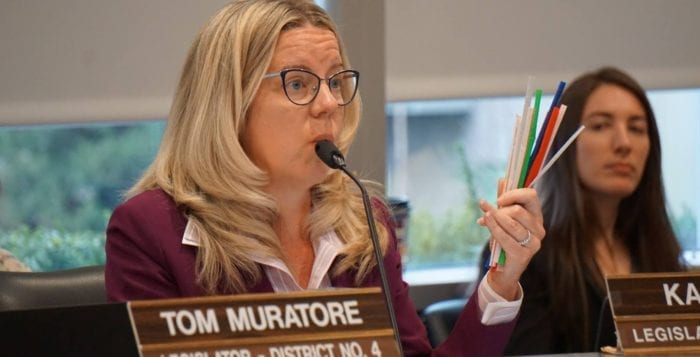
Several businesses have already converted to renewable products
Come January next year, Suffolk residents will likely be slurping down their iced coffees using paper straws, instead of the usual plastic.
As Suffolk lawmakers passed bills aimed at reducing plastic and polystyrene waste in the county April 9, food business owners will need to begin the process of adjusting to the new restrictions on plastic straws and polystyrene, more commonly known as Styrofoam, food service products.
As per the new bill, food establishments would be required to provide straws and stirrers by request only, and they would have to be biodegradable — not plastic. For customers with a disability or medical condition, plastic straws will be made available by request.
“The plastics crisis is more urgent than people realize.”
— Kara Hahn
“The scale of the worldwide single-use plastics problem has become an ever-increasing threat to our environment and everything that relies on it, including human health,” said Legislator Kara Hahn (D-Setauket). “The plastics crisis is more urgent than people realize.”
Some businesses in Suffolk County have already made the switch over to biodegradable options. Local’s Cafe in Port Jeff doesn’t use plastic straws and stirrers, and only uses paper goods, while Soul Brew in St. James said they switched over to paper goods at the end of last summer.
Constantinos Drepaniotis, co-owner of the Setauket Village Diner, said he and others have advocated for the environment and said the bans are quite a big step in right direction.
Drepaniotis’ diner hasn’t used Styrofoam food service products for close to two years and has begun reaching out to vendors for plastic straw alternatives. He has considered distributing reusable straws to his customers as well.
While the price of these alternatives has concerned business owners, the restaurant owner said it is business’ responsibility to be proactive and help in this environmental cause. The owner said he will not let the cost affect the business and it will adapt.
The Styrofoam bill would bar businesses from using items such as cups, trays and containers that are made from polystyrene, as well as ban retail stores from selling those products. It will require businesses in the county to use biodegradable products, though the bill would exempt items used to store uncooked eggs, raw meat, seafood and poultry. Changes would take effect Jan. 1, 2020.
The U.S. Department of Health and Human Services classified styrene as a potential human carcinogen and, according to the U.S. Environmental Protection Agency, polystyrene manufacturing process is the fifth largest creator of hazardous waste in the United States.
“[Styrene has] recently been upgraded from a possible carcinogen to a probable carcinogen — a cancer causing chemical,” Legislator Sarah Anker (D-Mount Sinai) said at a Feb. 13 press conference advocating for the bills. “Long Island has some of the highest cancer rates in the country.”

An employee from Tiger Lily Café in Port Jefferson said she dislikes plastic straws and hopes the new ban will potentially get people to bring their own reusable straws, mentioning that it is very expensive right now to purchase biodegradable alternatives, like paper straws.
While acknowledging the ban would be good for the environment, she said the cost is something a lot of entrepreneurs will have to deal with. The employee also hopes as the demands for these paper goods increase eventually the prices will go down and manufacturers will make it more cost effective.
Other businesses have been using alternatives to polystyrene containers. Setauket Pita House said it doesn’t use Styrofoam food containers and currently uses aluminum foil containers.
Officials also passed a third bill that would prohibit the sale of single-use plastic cups, utensils and beverage straws from county beaches and parks.
Last month, the Legislature approved a companion bill that would replace existing water fountains with new ones designed to allow bottle filling at county facilities and county-owned parks that have water dispensers.
The bills will now go to the county executive’s office to be signed into law.
Middle Country robotics teams to compete in prestigious world competition
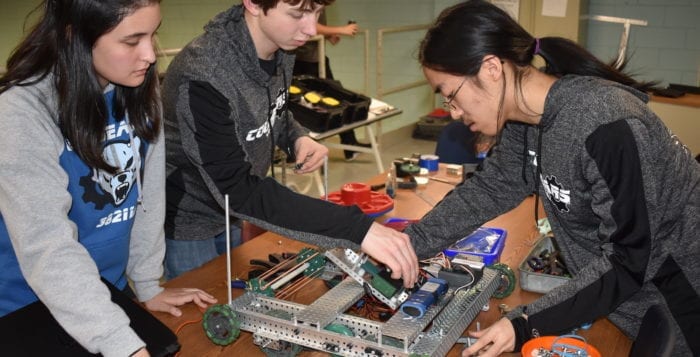
For the members of the Centereach and Newfield high school robotics teams, they have spent months and countless hours building and perfecting their robots in hopes of getting to their ultimate goal they set out at the start of the season. After both teams performed well at Southern New York State VEX Championships earlier this month, the duo has earned a spot in the VEX World Championships taking place April 24-27 in Louisville, Kentucky.
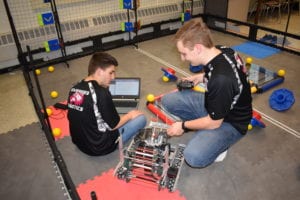
Nicholas Parrinello, Centereach Cougears Robotics adviser and technology teacher, said it all comes down to the student involvement.
“It is not a mentor- or teacher-built robot — it’s all them,” he said. “They come up with the design, test them and make sure it performs well.”
The second iteration of the CHS robotics club/team has been around for the past three years, and Parrinello said this has been the team’s best year culminating in the team being a semi-finalist at the state championship in March.
“To see your name on the screen in second place is a big deal,” he said. “It makes the time you put in worth it — it’s fulfilling.”
Cory Fitzgerald, Newfield Roverines Robotics adviser and technology teacher, said for his students it’s more than a club to them, it’s a culture that they get into and something they want to get better at.
“We had a very young team this year,” the NHS robotics adviser said. “We thought this would be a rebuilding year but we came in and did really well.”
The Roverines won the state championship in 2017 and 2018, and this is the third time the team will go to the world championship. Returning and new team members had some big shoes to fill after a majority of the team left for graduation.
Fitzgerald said initially in the beginning of the season the team didn’t fare too well in its first competition, getting eliminated in the semi-final. For some members of the team this was the first taste of defeat as up until that point they had never lost a competition, and they had made it to the finals of every competition they had been to in the past four years.
“It was a wake-up call for some of these students,” he said. “They came back to this room and disassembled the robots right down to the base and built another one from scratch.”
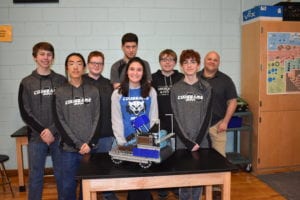
To the team’s credit, they bounced back winning, its next two regional competitions.
“The students have really progressed this year,” he said.
Team members of both teams reflected on their accomplishment and journey to get to Worlds.
“It’s exciting. It’s only our third year and its rewarding [to get to Worlds] after going through so much,” Victoria Heffern, president of the Centereach robotics team, said.
The CHS senior said when they first formed the team everything was new to them, and they were testing the waters and gaining experience. The team got better in their second year and they built on that coming into this season.
“It’s amazing how far we’ve come,” 11th-grader team member Kumpu Ide said.
Team member Erik Swanson said everyone spends a lot of time working on the robots trying to make it the best they can.
“We have shown to the district what we can do and what we are capable of,” the 11th-grader said. “It has allowed us to do more things. Without their support I don’t think we would be able to do what we are doing now.”
This year’s VEX robotics competition challenge is called Turning Point. The game is played on a 12’ x 12’ square field and there are two alliances, one red and one blue, that make up two teams each. The alliances compete in matches consisting of a 15-second autonomous period, followed by a two-minute, driver-controlled portion.
The goal of the game is to get the highest score than the opposing alliance, and they score points by completing a number of tasks including shooting balls at a colored flag, flipping caps to their designated color and climbing on a platform.
Carlie Flanagan, president of the Newfield robotics team said the team is looking forward to the upcoming competition.
“It’s a great experience,” the team president said. “It’s a competition, and we take it seriously, but we also try to have fun. There are a lot of teams that go once, but we are really lucky that we’ve been able to go the past three years.”
Kevin Swayze, lead builder and driver for the team, said it can get nervewracking sometimes during the elimination rounds in events, but it also builds confidence and he believes it’s a good experience overall.

“It’s really great. You meet people from different states and countries,” he said. “It’s fun, and it’s something you don’t get exposed to often.”
With the rise in demand of STEM-based education curricula in schools, the high schoolers agree that the exposure from being in the club has increased their interest in robotics, engineering and programming. Also, it has opened doors for them in their pursuit for a potential career down the line.
“A lot of the kids in the club have an interest and want to pursue it,” Parrinello said. “It is very fulfilling for me to see students excel.”
The CHS teacher said when students start in 9th grade, they are kind of green, and he tries to push them in a direction beginning with showing them the basic fundamentals of building a robot.
“People graduate, and the next class comes in there’s always those couple of kids that are really interested in it and that’s what I look for,” he said. “You look for the students that are inventive.”
Fitzgerald expressed similar sentiments saying he has a great group of students and a lot of them have a passion of going into the robotics field as well.
“By being here they are getting hands-on experience, learning how to write code and build robots,” he said.
Both Heffern and Flanagan plan on attending Worcester Polytechnic Institute in the fall to study robotics. CHS senior Aidan Donnelly plans on creating a VEX robotics team at his college.
The returning members on both teams hope to expand the club and team in the coming years
“We want to expand the program and possibly have multiple teams, so everyone can get hands-on experience,” CHS 11th-grader Ide said.
NHS team member Jackson Mazer said around 50 students expressed interest in the club this past year. A majority of them were freshmen.
“One of our goals [in the beginning of the season] was to make it to this competition. Now all of our goals is to go further and maybe win this thing,” CHS 11th-grader Swanson said.
Business News: NEFCU holds ribbon cutting for Huntington branch
RIBBON CUTTING
Long Island based credit union NEFCU formally opened its 19th branch on the Island with a ribbon-cutting ceremony on April 4. Located at 356 New York Ave., Huntington, the 2,067-square-foot location first opened for business in late January.
The event was attended by a number of NEFCU representatives and local officials including Town of Huntington Supervisor Chad Lupinacci (R) who presented NEFCU President and CEO John Deieso with a Certificate of Recognition.
This marks the second Huntington area branch for the credit union after opening its doors in Huntington Station in 2015 at 721 Jericho Turnpike.
“We’re Long Island born and bred, and we’re continually looking for communities across this hard-working island to put down new roots,” said Deieso. “Suffolk County presents a great opportunity for us, and we’re rapidly making our name known as we move eastward. And we’re finding that existing and new members are attracted to our digital and mobile banking offerings that are augmented by an increased level of personal service.”
In the photo, from left, Jillian Guthman, receiver of taxes, Town of Huntington; Lupinacci; Madeleine Sewell, NEFCU assistant treasurer; Deieso; Councilman Ed Smyth (R); and Michael Varriale, NEFCU branch manager.
Photo of the Week
SPECTACULAR SUNSET
Dotty Connor of East Setauket happened on this beautiful sunset while walking around the Village of Port Jefferson on March 25. She writes, ‘I only had my iPhone 7 and a minute to capture this. We are so lucky to live in such a beautiful place.
Send your Photo of the Week to [email protected]
Legally Speaking: Who has the legal authority to sign a deed?
By Linda Toga Esq.
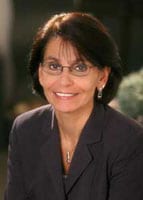
THE FACTS: Last year my aunt Sue died without a will. She was widowed and owned a house that had been in our family for generations. The understanding was that when she died, the next generation, including me and my siblings, would inherit the house. Recently, my aunt’s daughter, Mary, signed a deed transferring the house to herself and her only sibling, Jane.
THE QUESTION: Did Mary have the legal authority to transfer the property?
THE ANSWER: Unfortunately for you, as Sue’s daughter and a distributee of Sue’s estate, Mary was well within her rights to transfer the property. If Sue had a will in which she left you and your siblings a share of the house, Mary would not have been able to transfer the property to herself and Jane. She would have first been required to obtain letters testamentary from the Surrogate’s Court (assuming she was named as executrix in the will) and she would then have to abide by the terms of the will by transferring the house to the beneficiaries named in the will.
However, since Sue died without a will, by law title to the house automatically vested in her children when she died. In other words, as Sue’s only children, Mary and Jane immediately became the legal owners of the house when Sue died. The law that addresses vesting does not apply to you or your siblings because you are not in Sue’s direct bloodline. If Sue did not have any children, the outcome may have been different.
If Sue wanted you and your siblings to have a share of the family home, she should have had an estate planning attorney prepare a will for her in which her wishes with respect to the property were memorialized. The executor of the estate would then be obligated to carry out Sue’s wishes and transfer the property to you, your sibling and any other beneficiaries set forth in the will. Absent a will, you have no claim to the house.
Linda M. Toga provides legal services in the areas of estate planning/elder law, probate and estate administration, real estate, small business service and litigation from her East Setauket office.
Cooking Cove: Easter and Passover share side dishes
By Barbara Beltrami
With the spring holidays falling simultaneously this year, it’s nice to share recipes that are appropriate for either Easter or Passover dinner. And with meat becoming less and less the centerpiece for these occasions and vegetables becoming more and more the main attraction, the old boiled and baked versions need some updating. Adding lemon and/or herbs is one way to make those veggies more interesting; combining and roasting them is another. And while all veggies can be tweaked and turned into wonderful accompaniments and features for the holidays, because it is spring, I like to focus on the seasonal ones. The following recipes are all oven done and can be cooked right along with a roast.
Lemon Roasted Asparagus
 YIELD: Makes 8 servings.
YIELD: Makes 8 servings.
INGREDIENTS:
2 pounds fresh asparagus, washed and trimmed
¼ cup extra virgin olive oil
2 garlic cloves, minced
2 shallots, diced
Coarse salt and freshly ground pepper, to taste
1 tablespoon lemon zest
Juice of one lemon
DIRECTIONS:
Preheat oven to 425 F. Lay asparagus in greased shallow nonreactive baking pan. In a small bowl whisk together remaining ingredients, drizzle over asparagus and toss to coat well. Roast until asparagus is tender but still bright green, about 15 to 20 minutes. Transfer to warm platter and drizzle any remaining juices over top. Serve hot or warm with meat, poultry or fish.
Roasted Ratatouille
YIELD: Makes 6 to 8 servings.
INGREDIENTS:
1 large zucchini, cut into 2-inch chunks
1 large eggplant, cut into 2-inch chunks
1 large onion, coarsely chopped
1 green bell pepper, coarsely chopped
1 yellow bell pepper, coarsely chopped
4 medium tomatoes, cut into 6 wedges each
½ cup extra virgin olive oil
½ cup chopped fresh flat-leaf parsley
2 tablespoons fresh chopped basil leaves or 2 teaspoons dried
1 tablespoon fresh thyme leaves or 1 teaspoon dried
Coarse salt and freshly ground pepper to taste
DIRECTIONS:
Preheat oven to 400 F. Toss all ingredients together in a large baking dish; cover with aluminum foil and, scraping and stirring 2 or 3 times, bake for 30 minutes or until all veggies are tender. Remove foil and roast another 10 to 15 minutes until slightly brown. Transfer to a warm dish and serve hot or warm with meat, poultry or fish.
Tarragon Roasted Carrots and Fennel
YIELD: Makes 8 servings.
INGREDIENTS:
1 pound carrots, peeled and cut into ½-inch diagonal slices
1 fennel bulb, trimmed and sliced into 1-inch wedges
¼ cup extra virgin olive oil
1 tablespoon fresh tarragon leaves or 1 teaspoon dried
Coarse salt and freshly ground pepper to taste
DIRECTIONS:
Preheat oven to 400 F. Place carrots and fennel in a shallow roasting pan. In a small bowl, whisk together the oil, tarragon, salt and pepper and pour over veggies; toss thoroughly to coat. Cover with aluminum foil and bake 20 to 30 minutes, until tender; remove foil and bake 5 to 10 minutes more until slightly brown on top. Transfer to warm platter and serve hot or warm with meat, poultry or fish.
New Potato Pancake with Green Onions
YIELD: Makes 4 to 6 servings.
INGREDIENTS:
3 pounds tiny new potatoes, scrubbed and sliced very thin
1 bunch green onions, trimmed and sliced
½ cup extra virgin olive oil
Coarse salt and freshly ground pepper, to taste
3 tablespoons chopped fresh flat-leaf parsley
DIRECTIONS:
Preheat oven to 400 F. Generously grease 9-inch iron skillet or round baking pan. In a large bowl, toss together the potato slices, onion, oil, salt and pepper and turn into skillet or baking pan. Smooth out mixture so all potato slices are lying flat. Bake until potatoes are tender and bottom of mixture is golden, about 25 to 30 minutes. Preheat broiler; slide pan under broiler and cook until top is crisp and golden, about 5 minutes. Remove, loosen sides and bottom with spatula and invert onto warm serving platter or leave right side up, if desired and top with parsley. Serve warm or hot with meat, poultry or fish.




